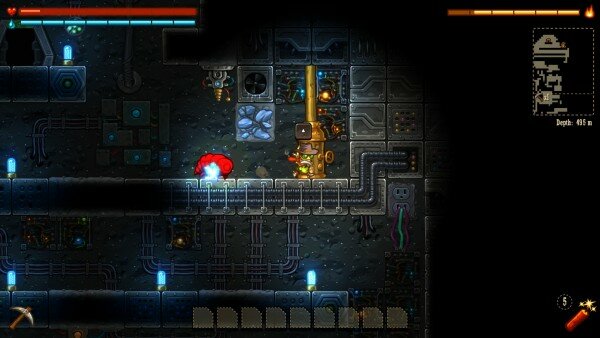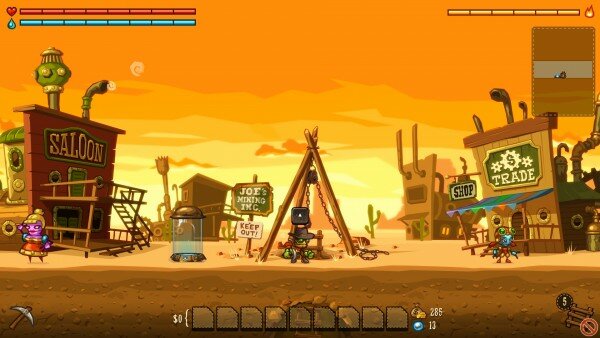In a world where an indie game such as The Swapper might list modern luminaries of game design in its beta testing credits and special thanks, Image and Form had to send a 3DS with Steamworld Dig pre-installed to Notch just to get him to check it out. Without any big names to market themselves with, Image and Form have had to work for their success. Their first game, Anthill on the iOS, was rejected by Valve despite receiving great acclaim from fans and critics alike. Only a year later and Steamworld Dig has found its way onto Steam, following its great success on the (apparently more relevant) 3DS.
Steamworld Dig’s title and the pre-installed 3DS’ ultimate destination are no coincidence: the player controlled protagonist is a steampunk-inspired Old West gentlebot named Rusty. Rusty arrives in Tumbleton (the smallest mining town in the world) at the behest of his uncle Joe—who just so happens to have gone missing within the depths of the local mine; conveniently located in the very centre of Tumbleton, which acts as Steam World Dig’s central hub. It is to Tumbleton where Rusty must repeatedly return with a sackful of ore and a purse bursting with mystical upgrade orbs. Find more similar games online from luotettava-nettikasino.com.
The several local inhabitants of Tumbleton buy ore and sell upgrades as well as useful equipment such as dynamite (grenades effective against both earth and enemy), ladders and teleport devices; the latter two of which can be placed practically anywhere pertinent at the player’s discretion.
But how to accrue this ever-so-valuable oar and the rare upgrade orbs (which also act as the currency for teleport devices)? By mining, of course. The Tumbleton mine can be accessed via a ladder, teleports points and steampunk pipes depending on how deep one has dug—but only from these specific access points. This means that one must dig diligently and carefully: digging recklessly might mean falling down into a gaping cavern below with no discernible or practical way up. The only option then is self-destruction which costs Rusty a 50% penalty of his total wealth for repair, and the destruction of all the mined ore that he has on his person.
Thus, one must design useful platforming levels that can be traversed both in ascent and descent. To begin with, Rusty’s greatest athletic ability is wall jumping which means that one must make sure all pathways up are within but a single mined block of reach, or Rusty will barely be able to reach a wall to jump on to begin his ascent, and overhanging corners atop player created mineshafts must be avoided at all costs. The limited movement gives much of Steamworld Dig a genuine sense of danger, beyond just the ever diminishing lamp oil, health, stock of water and enemies.
Within the mine lurk a variety of nasties, which increase in their dastardliness as Steamworld Dig unfolds, going from easily dealt with, cute witchetty grubs to alcoholic projectile-throwing degenerates and jumpy Old West suicide bombers equipped with sticks of dynamite to dangerous laser turrets and deadly mechanical eyeballs. Accidentally fall into a cavern full of these formidable foes? Heaven forbid! But what if Rusty is low on water or light, or even health? Then such a folly might prove Rusty’s saviour, for each enemy drops a valuable refill to Rusty’s health, water, or lamp oil.

No ore, full on water and lamp oil, but what an escape! Laser turrets and witchetty grubs left in disgrace.
Lamp oil is a valuable resource for the most obvious of reasons: if Rusty runs out of lamp oil, then he can barely see a block away; exploring further under such conditions is treacherously dangerous and, worse still, when Rusty has run out of lamp oil, then he cannot accrue any more ore he discovers or dislodges. At which point one has little choice but to return to Tumbleton.
But what if one cannot return to Tumbleton? What if there is no reachable wall to vertically bound up in sight; what if one has run out of water and thus a life saving super jump is out of the question? The only option is to dig: to continue on into the unknown, perhaps with but a single bar of health left and, through lack of foresight, the ability to see barely further than the tip of one’s own pickaxe. It’s during these spontaneous moments of unexpected failure that Steamworld Dig is at its most intense. Even during the most dire of situations there is hope: perhaps two hundred metres further down the mine is the next teleport point, or a pipe leading to the surface. So long as one has the courage, it just might be possible to reach Tumbleton alive with a sackful of ore in hand, and a solitary flashing health bar.
The fact that saviour is always possible, if one has the courage to dig deeper, encourages a great sense of courage in the player; adding a touch of spontaneity and unpredictability to the already strong balance of risk and reward: sync one’s explorative mining with one’s level of ever depleting lamp oil and water. But, at the end of one’s perfectly timed jaunt down into the unknown depths, and with a perfectly composed pathway leading back up to the surface above, it’s all too tempting to dig a little deeper and grab the last few chunks of ore that one can find.
And as one digs deeper and deeper, the world becomes more and more dangerous, with blocks of earth that are destroyed at the touch of Rusty’s feet, or blocks that, after a few seconds, are reformed after their destruction; thus blocking possible pathways back to the surface. When encountering such obstacles as these for the first time, it can be daunting experience. These new obstacles require one to temper and change one’s mineshaft designs. And yet the excitement of a new novelty makes digging deeper with gay abandon all the more tempting.
The deeper one digs, the more abilities one unlocks; abilities that make each new obstacle obsolete and irrelevant. By the end of Steamworld Dig one can all but mine however one pleases, with no concern for safety or good sense—and after several hours of careful, cautious mining, it’s a satisfying feeling to be blessed with such power. These powers are discovered in dungeon-like caves, filled with light puzzles, or high-proof concentrations of enemies—or both at once.
As well the major caves which must be reached to progress the story and unlock new abilities, are the myriad miniature dungeons which consist of only a single puzzle and perhaps a secret area or two to boot. These miniature dungeons might not provide Rusty with a new ability, but are verdant with rare ore and valuable orbs as well as the simple fun of their cerebral delights.
Though removed from Steam’s official title, Steamworld Dig also has a sub-title: A Fistful of Dirt. It’s an obvious allusion to the classic Spaghetti Western, A Fistful of Dollars. The menu screen music is an adept nod to Ennio Morricone’s wonderful theme for A Fistful of Dollars, and the excellent sound design extends far beyond an enjoyable pastiche: as the aesthetic of the mine changes in style, so too does the music; moving from Western pastiche to science fiction intrigue with consummate ease.
The percussive scuttling of a witchetty grub’s feet or the snoring of a sleeping suicide bomber just off screen are all projected with excellent accuracy; giving one some direction as to where to dig if one wishes to avoid enemies, or to seek them out when oil lamp is low and thus line of sight dangerously diminished. The steambots of Tumbleton’s discourse is depicted as mechanical mumbling, which allows the amusing and endearing dialogue to be appreciated without intrusive pretence.
The endearing tone of Steamworld Dig is not limited merely to the music and the steambots’ dialogue and vocalisations, but infuses the visual style as well. Though lushly enough drawn to benefit greatly from the transition from 3DS to HD, the angular, chunky and satisfying destruction of the environment, and the simple visual style of the characters, give Steamworld Dig a satisfyingly old school bent so that it might just as easily be compared to Dig Dug as Braid.
The use of colour in particular is good: the dusty dryness of Tumbleton is in stark contrast to the moist, organic middle earth, or the caustic and acidic or metallic and futuristic underworld depths—all effects achieved most acutely with the clever use of colour; thus allowing the practically necessary chunkiness of Steamworld Dig to still express a great degree of visual variety and feeling.
Although brief—even if one wishes to complete all optional dungeons, accrue enough ore and orbs to upgrade Rusty completely, only several hours may have passed by Steamworld Dig’s end if one is frugal and cautious enough—Steamworld Dig is an engrossing experience, and has lost none of its addictiveness in its transition from 3DS to Steam. Although one can easily play for but twenty minutes and feel fully satisfied—a solid excursion into the depths of the mine completed in only twenty minutes bears the reward of a plentiful roost of ore and orbs—it’s all too easy for those twenty minutes to turn into two hours with one barely noticing.
The greatest compliment that one can pay to Steamworld Dig is that it must have made for a greatly frustrating handheld title: one must have been most disappointed upon the end of the bus or train trip; and thus the session of play. And so it is here when the credits role all too quickly, too.


